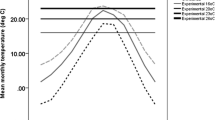Abstract
The effects of rearing and acclimation on the response of adultDrosophila to temperature were investigated in a gradient.D. melanogaster flies preferred a higher mean temperature and were distributed over a wider range of temperatures thanD. simulans flies. Acclimating adults at different temperatures for a week did not influence the response of either species. Adults reared at 28°C as immatures had a lower mean preference than those reared at cooler temperatures, suggesting that flies compensated for the effects of rearing conditions. Adults from tropical and temperate populations ofD. melanogaster andD. simulans did not differ in the mean temperature they preferred in a gradient, suggesting little genetic divergence for this trait within species. The species differences and environmental responses may be related to changes in optimal physiological conditions for the flies.
Similar content being viewed by others
References
Burnell, A. M., Reaper, C., and Doherty, J. (1991). The effect of acclimation temperature on enzyme activity inDrosophila melanogaster.Comp. Biochem. Physiol. 98B 609–614.
Cohet, Y., Vouidibio, J., and David, J. R. (1980). Thermal tolerance and geographic distribution: A comparison of cosmopolitan and tropical endemicDrosophila species.J. Therm. Biol. 5 69–74.
Crill, W. D. and Huey, R. B. (1994). Within and cross-generational effects of temperature on the physiology and morphology ofDrosophila melanogaster. Animal Behaviour (in press).
David, J. R., Allemand, R., Van Herrewege, J., and Cohet, Y. (1983). Ecophysiology: Abiotic factors. In: Ashburner, M., Carson, H. L., and Thompson, J. N. (eds.),The Genetics and Biology of Drosophila 3d, Academic Press, London, pp. 105–170.
Fogleman, J. C. (1979). Oviposition site preference for substrate temperature inDrosophila melanogaster.Behav. Genet. 9 407–411.
Good, D. S. (1993). Evolution of behaviours inDrosophila melanogaster in high temperatures: Genetic and environmental effects.J. Insect Physiol. 39 537–544.
Hochachka, P. W., and Somero, G. N. (1984).Biochemical Adaptation, Saunders, Philadelphia.
Hoffmann, A. A., and Watson, M. (1993). Geographic variation in the acclimation responses ofDrosophila to temperature extremes.Am. Nat. 142 S93-S113.
Jones, J. S., Coyne, J. A., and Partridge, L. (1989). Estimation of the thermal niche ofDrosophila melanogaster using a temperature-sensitive mutation.Am. Nat. 130 83–90.
Levins, R. (1969). Thermal acclimation and heat resistance inDrosophila species.Am. Nat. 103 483–499.
Parsons, P. A. (1978). Habitat selection and evolutionary strategies inDrosophila: An invited address.Behav. Genet. 8 511–526.
Parsons, P. A. (1980). Adaptive strategies in natural populations ofDrosophila.Theor. Appl. Genet. 57 257–266.
Pertunnen, J. T., and Salmi, H. (1956). The responses ofDrosophila melanogaster (Dipt. Drosophilidae) to the relative humidity of the air.Suom. hyont. Aikak. 22 63–71.
Prince, P. J., and Parsons, P. A. (1977). Adaptive behaviour ofDrosophila adults in relation to temperature and humidity.Aust. J. Zool. 25 285–290.
Stanley, S. M., Parsons, P. A., Spence, G. E., and Weber, L. (1980). Resistance of species of theDrosophila melanogaster subgroup to environmental extremes.Aust. J. Zool. 28 413–421.
Tantawy, A. O., and Mallah, G. S. (1961). Studies on natural populations ofDrosophila. I. Heat resistance and geographical variation inDrosophila melanogaster andD. simulans.Evolution 15 1–14.
Zar, J. H. (1984).Biostatistical Analysis, 2nd ed., Prentice-Hall Englewood Cliffs, NJ.
Author information
Authors and Affiliations
Rights and permissions
About this article
Cite this article
Krstevska, B., Hoffmann, A.A. The effects of acclimation and rearing conditions on the response of tropical and temperate populations ofDrosophila melanogaster andD. simulans to a temperature gradient (Diptera: Drosophilidae). J Insect Behav 7, 279–288 (1994). https://doi.org/10.1007/BF01989735
Accepted:
Issue Date:
DOI: https://doi.org/10.1007/BF01989735




